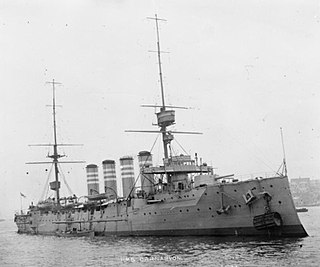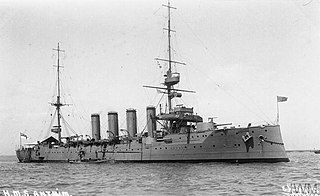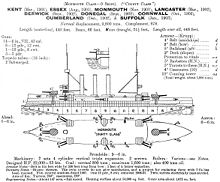
The Battle of Coronel was a First World War naval battle that led to an Imperial German Navy victory over the Royal Navy on 1 November 1914, off the coast of central Chile near the city of Coronel. The East Asia Squadron of the Imperial German Navy led by Vice-Admiral Graf Maximilian von Spee met and overpowered a British squadron commanded by Rear-Admiral Sir Christopher Cradock.

SMS Scharnhorst was an armored cruiser of the Imperial German Navy, built at the Blohm & Voss shipyard in Hamburg, Germany. She was the lead ship of her class, which included SMS Gneisenau. Scharnhorst and her sister were enlarged versions of the preceding Roon class; they were equipped with a greater number of main guns and were capable of a higher top speed. The ship was named after the Prussian military reformer General Gerhard von Scharnhorst and commissioned into service on 24 October 1907.

The Battle of the Falkland Islands was a First World War naval action between the British Royal Navy and Imperial German Navy on 8 December 1914 in the South Atlantic. The British, after their defeat at the Battle of Coronel on 1 November, sent a large force to track down and destroy the German cruiser squadron. The battle is commemorated every year on 8 December in the Falkland Islands as a public holiday.

HMS Good Hope was one of four Drake-class armoured cruisers built for the Royal Navy around 1900; she was originally named Africa, but was renamed before she was launched. She became flagship of the 1st Cruiser Squadron of the Atlantic Fleet in 1906, and was the flagship of the 2nd Cruiser Squadron in 1908. She was reduced to reserve in 1913, but was recommissioned in mid-1914.

HMS Kent was one of 10 Monmouth-class armoured cruisers built for the Royal Navy in the first decade of the 20th century. She was placed in reserve when completed in 1903, but was recommissioned for the China Station in 1906. She remained there until she returned home in 1913 for a lengthy refit.

HMS Carnarvon was one of six Devonshire-class armoured cruisers built for the Royal Navy in the first decade of the 20th century. She was assigned to the 3rd Cruiser Squadron of the Mediterranean Fleet upon completion in 1905 and was transferred to the 2nd Cruiser Squadron of the Atlantic Fleet in 1907. She was assigned to the reserve Third Fleet in 1909 and became flagship of the 5th Cruiser Squadron of the reserve Second Fleet in 1912.

HMS Canopus was a pre-dreadnought battleship of the British Royal Navy and the lead ship of the Canopus class. Intended for service in Asia, Canopus and her sister ships were smaller and faster than the preceding Majestic-class battleships, but retained the same battery of four 12-inch (305 mm) guns. She also carried thinner armour, but incorporated new Krupp steel, which was more effective than the Harvey armour used in the Majestics. Canopus was laid down in January 1897, launched in October that year, and commissioned into the fleet in December 1899.

HMS Cornwall was one of 10 Monmouth-class armoured cruisers built for the Royal Navy in the first decade of the 20th century. She was assigned to the 2nd Cruiser Squadron of the Channel Fleet on completion in 1903. The ship was refitted in 1907 in preparation for service as a training ship for cadets with the 4th Cruiser Squadron on the North America and West Indies Station beginning in 1908.

SMS Gneisenau was an armored cruiser of the German Kaiserliche Marine, part of the two-ship Scharnhorst class. Named for the earlier screw corvette of the same name, the ship was laid down in June 1904 at the AG Weser shipyard in Bremen, launched in June 1906, and commissioned in March 1908. She was armed with a main battery of eight 21 cm (8.3 in) guns, a significant increase in firepower over earlier German armored cruisers, and she had a top speed of 22.5 knots. Gneisenau initially served with the German fleet in I Scouting Group, though her service there was limited owing to the British development of the battlecruiser by 1909, which the less powerful armored cruisers could not effectively combat.

The Cressy-class cruiser was a class of six armoured cruisers built for the Royal Navy around 1900. Their design's incorporation of a pair of 9.2-inch guns and armoured sides served to address criticism directed against the previous Diadem class — advances made possible by their 1,000 ton increase in displacement over their predecessors. The ships were notably stable, except for a susceptibility to pitching.

HMS Monmouth was the name ship of her class of 10 armoured cruisers built for the Royal Navy in the first decade of the 20th century. The ships were also known as the County Cruisers.

HMS Glasgow was one of five ships of the Bristol sub-class of the Town-class light cruisers built for the Royal Navy in the first decade of the 20th century. Completed in 1910, the ship was briefly assigned to the Home Fleet before she was assigned to patrol the coast of South America. Shortly after the start of the First World War in August 1914, Glasgow captured a German merchant ship. She spent the next several months searching for German commerce raiders. The ship was then ordered to join Rear Admiral Christopher Cradock's squadron in their search for the German East Asia Squadron. He found the German squadron on 1 November off the coast of Chile in the Battle of Coronel. They outnumbered Cradock's force and were individually more powerful, sinking Cradock's two armoured cruisers, although Glasgow was only lightly damaged.

The Drake class was a four-ship class of armoured cruisers built around 1900 for the Royal Navy.

The Devonshire-class cruiser was a group of six armoured cruisers built for the Royal Navy in the first decade of the 20th century. All ships of the class served in World War I. Argyll was wrecked, and Hampshire was sunk by a naval mine. The four survivors were disposed of soon after the war.

HMS Suffolk was one of 10 Monmouth-class armoured cruisers built for the Royal Navy in the first decade of the 20th century. Upon completion she was assigned to the 3rd Cruiser Squadron of the Mediterranean Fleet and was then assigned to the 5th Cruiser Squadron in the Mediterranean in 1909 after a lengthy refit. She returned home for another refit in 1912 and became the flagship of the 4th Cruiser Squadron on the North America and West Indies Station in 1913.

HMS Berwick was one of 10 Monmouth-class armoured cruisers built for the Royal Navy in the first decade of the 20th century. She was assigned to the 2nd Cruiser Squadron of the Channel Fleet upon completion in 1903 and was transferred to the Home Fleet in 1906. She accidentally rammed and sank a British destroyer in 1908. Berwick was refitted in 1908–09 before she was transferred to the 4th Cruiser Squadron on the North America and West Indies Station later that year.

HMS Cumberland was one of 10 Monmouth-class armoured cruisers built for the Royal Navy in the first decade of the 20th century. She was assigned to the 2nd Cruiser Squadron of the Channel Fleet upon completion in 1903. After a refit in 1907–1908 she became a training ship in the Home Fleet. She was sent to West Africa after the beginning of World War I in August 1914 and captured 10 German merchant ships in September. Cumberland spent the rest of the war on convoy escort duties and patrolling for German commerce raiders. She was sold for scrap in 1921 and broken up two years later.

HMS Donegal was one of 10 Monmouth-class armoured cruisers built for the Royal Navy in the first decade of the 20th century. She was initially assigned to the 1st Cruiser Squadron upon completion in 1903 and ran aground en route to the China Station in 1906. She was briefly placed in reserve after repairs before she was assigned to the Home Fleet in 1907. She joined the 4th Cruiser Squadron on the North America and West Indies Station in 1909 before returning home for an assignment with the Training Squadron in 1912. Donegal was reduced to reserve before World War I began in August 1914 as part of the Third Fleet

HMS Lancaster was one of 10 Monmouth-class armoured cruisers built for the Royal Navy in the first decade of the 20th century. Upon completion she was assigned to the 3rd Cruiser Squadron of the Mediterranean Fleet. She remained there until 1912 when she returned home to be placed in reserve. The ship was recommissioned in 1913 for service with the 4th Cruiser Squadron on the North America and West Indies Station. She remained there until she was assigned to the Grand Fleet in 1915. She was transferred to the Pacific in 1916 and she became flagship of the Eastern Squadron in 1918. The ship was sold for scrap in 1920.

SMS Nürnberg, named after the Bavarian city of Nuremberg, was a Königsberg-class light cruiser built for the German Imperial Navy. Her sisters included Königsberg, Stettin, and Stuttgart. She was built by the Imperial Dockyard in Kiel, laid down in early 1906 and launched in August of that year. She was completed in April 1908. Nürnberg was armed with ten 10.5 mm (0.41 in) guns, eight 5.2 cm (2 in) SK L/55 guns, and two submerged torpedo tubes. Her top speed was 23.4 knots.























